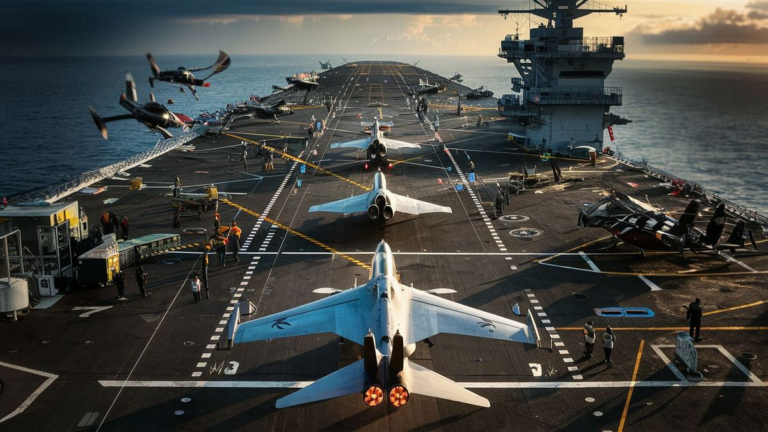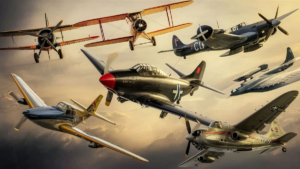When it comes to the operational capabilities of an aircraft carrier, the length of its runway is a critical factor. The unique design and engineering of aircraft carrier runways, often referred to as flight decks, set them apart from traditional land-based runways.
The Basics of Aircraft Carrier Runways
The length of an aircraft carrier runway is commonly known as the deck length. Unlike conventional runways, aircraft carrier decks are significantly shorter due to space constraints on the ship. The average deck length ranges from 600 to 1,090 feet, depending on the class of the aircraft carrier.
Varied Deck Lengths Across Carrier Classes
Various classes of aircraft carriers have different deck lengths to accommodate a diverse range of aircraft. For instance, the Nimitz-class carriers, one of the most prominent classes in the United States Navy, have a deck length of about 1,092 feet. On the other hand, the Gerald R. Ford-class carriers, the newest and most advanced, boast a longer deck at approximately 1,106 feet.
Factors Influencing Deck Length
Several factors contribute to determining the length of an aircraft carrier runway. The primary considerations include the takeoff and landing requirements of the aircraft, the speed of the carrier, and the available space on the ship. Engineers meticulously calculate these factors to ensure the safe and efficient operation of the carrier’s air wing.
The Role of Catapults and Arresting Gear
Aircraft carriers utilize catapults to assist in the takeoff of aircraft. This technology enables planes to achieve the necessary takeoff speed within the limited deck length. Additionally, arresting gear, such as cables and hooks, helps safely decelerate landing aircraft on the short runway.
Operational Advantages of Short Runways
The relatively short length of aircraft carrier runways provides strategic advantages. Carriers can operate in confined spaces and closer to the action, allowing for more rapid deployment of air power. This capability is especially crucial in dynamic and evolving military scenarios.
Flexibility in Deployment
Short runways afford aircraft carriers the flexibility to navigate through narrow and challenging waters, making them instrumental in both combat and humanitarian missions. The ability to position carriers strategically enhances their effectiveness in various global scenarios.
In summary, the length of an aircraft carrier runway, or deck, is a carefully calculated parameter that takes into account the specific needs of the carrier’s air wing and the constraints of ship design. The operational advantages of short runways contribute to the versatility and effectiveness of aircraft carriers in a range of military and humanitarian operations.
Frequently Asked Questions about Aircraft Carrier Runways
As we delve deeper into the specifics of aircraft carrier runways, it’s essential to address common questions that arise regarding their design and functionality. Here are some frequently asked questions:
-
Q1: How do engineers determine the optimal deck length for an aircraft carrier?
A: Engineers consider factors such as aircraft takeoff and landing requirements, carrier speed, and available space on the ship. These parameters are meticulously calculated to ensure safe and efficient operations.
-
Q2: What role do catapults play in the takeoff of aircraft from carriers?
A: Catapults are crucial for assisting aircraft takeoff on short carrier runways. They help planes achieve the necessary takeoff speed within the limited deck length, enhancing the carrier’s operational capabilities.
-
Q3: How does the deck length vary across different classes of aircraft carriers?
A: Different classes exhibit varied deck lengths to accommodate a diverse range of aircraft. For example, the Nimitz-class carriers have a deck length of about 1,092 feet, while the Gerald R. Ford-class carriers boast a longer deck at approximately 1,106 feet.
Optimizing Aircraft Carrier Runway Operations
Aside from the length considerations, optimizing the overall operations of aircraft carrier runways involves advanced technologies and strategic planning. Let’s explore additional aspects:
Advanced Technologies: Electromagnetic Aircraft Launch System (EMALS)
Modern aircraft carriers, such as those in the Gerald R. Ford class, employ advanced technologies like EMALS for catapult launches. EMALS provides more precise control over takeoff parameters, improving the efficiency and safety of aircraft operations on the deck.
Future Innovations: Autonomous Aircraft Operations
Looking ahead, the future of aircraft carrier operations may involve autonomous aircraft launches and recoveries. Research and development in unmanned aerial systems (UAS) aim to enhance the flexibility and capabilities of carrier-based air wings.
See also:






